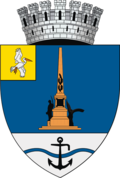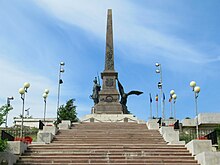Tulcea
| Tulcea | ||||
|
||||
| Basic data | ||||
|---|---|---|---|---|
| State : |
|
|||
| Historical region : | Dobruja | |||
| Circle : | Tulcea | |||
| Coordinates : | 45 ° 11 ' N , 28 ° 48' E | |||
| Time zone : | EET ( UTC +2) | |||
| Height : | 30 m | |||
| Area : | 115 km² | |||
| Residents : | 73,707 (October 20, 2011) | |||
| Population density : | 641 inhabitants per km² | |||
| Postal code : | 820033 | |||
| Telephone code : | (+40) 02 40 | |||
| License plate : | TL | |||
| Structure and administration (as of 2016) | ||||
| Community type : | Municipality | |||
| Structure : | 1 District / cadastral municipality: Tudor Vladimirescu | |||
| Mayor : | Constantin Hogea (independent) | |||
| Postal address : | St. Păcii, no. 20 loc. Tulcea, jud. Tulcea, RO-820033 |
|||
| Website : | ||||
Tulcea [ ˈtult͜ʃe̯a ] ( German Tultscha ) is a city in Romania and the capital of the Tulcea district of the same name . In 2011 the city on the Danube had around 73,700 inhabitants.
location
Tulcea lies on the right bank of the Danube, on seven hills, exactly at the point where the Danube makes a sharp bend to the east. On the opposite bank, in the loop of the curve, is Tudor Vladimirescu , a formerly independent place called Carantena , which is now a district of Tulcea. Tulcea International Airport is 15 kilometers away .
history
In the 8th century BC The city was founded by the Greek world traveler, ethnologist and geographer Herodotus of Halicarnassus in the 3rd century BC. First mentioned under the name Castrum Aegyssus ; also Diodorus mentioned it. In his work Epistulae ex Ponto, Ovid traces the name of the city back to the Dacian founder Carpyus Aegyssus.
Tulcea has been an important port city since ancient times. After its conquest by the Romans in the first century, it was the base of the Roman Northeast Fleet. The Roman Legion I Iovia Scythica was stationed there with a unit and as Legio ripariensis ("Shore Legion ") guarded the border to the Barbaricum on the Danube . Later, the city was under alternating rule by Byzantium (5th and 6th centuries), Bulgaria (from 6th to 10th and 12th to 14th centuries), Genoa (from 10th to 13th centuries) and local Kingdoms such as the Bulgarian despotate Dobruja and Wallachia under Mircea cel Bătrân .
In 1417 the city was conquered by the Ottoman Empire and renamed Hora-Tepé or Tolçu . Bulgarians established the first private hospital on the Balkan Peninsula here in 1807. On March 11 (23), 1854, Tulcea was captured by the Russian army in the course of the Crimean War , but the troops had to leave the city in June 1854 to take part in the fighting on the Crimean peninsula. In 1860 the place received the rank of city as the district capital. Until 1878 Tulcea was the bishopric of the Bulgarian Exarchate . After the Berlin Congress of 1878, Tulcea was awarded to Romania together with the North Dobrudscha . Until 1940 Tulcea was mostly inhabited by Bulgarians, who, however , left the city after the Treaty of Craiova .
economy
Tulcea is still an important port city, is also the base of the Romanian river navy and is considered the gateway to the Danube Delta , which is a protected natural world heritage site . The city also has a small regional airport. Tulcea is an important industrial city with shipyards and textile industries. The largest shipyard was built under Ceaușescu in the 1960s and was the largest employer in town. After the fall of the Wall there were fewer orders and the number of employees had to be reduced.
There is also a large aluminum smelter in Tulcea . After the political change, the factory had to stop production because of environmental problems. But around 2002 a Russian investor was found who resumed production, albeit in smaller quantities. A gradual modernization of the smelting plant is in progress.
From the 1990s on, tourism became a new and important economic factor. The number of hotels and excursion companies increased accordingly.
shipping
- From Tulcea, passenger ships regularly sail into the Danube Delta during the summer season . These boat tours are also offered, arranged and partly organized to hotel guests.
- Private boat operators also offer a taxi-like crossing to Ismajil in Ukraine from Tulcea . Because of the formalities, you should plan a day's lead time.
- The port has been expanded in recent years.
Nature and buildings
Museums
- History Museum of the Danube Delta
- Folk Art Museum
- Art museum “G. Georgescu "
- Museum of Archeology and History in Independence Park, in the center of which stands a 22-meter-high granite obelisk, inaugurated in 1899, on a hill above the Danube
Churches
- Orthodox Episcopal Church of St. Nikolai ; Erected in 1865, for the construction of the tower a sultan's decree , the so-called Irade , was required
- Mosque Azizie , which dates from the second half of the 19th century and in typical Turkish style was built
- George's Church with the depiction of the dragon slayer on the facade and the only clock tower in the city
- Romanian Orthodox Church of the Holy King Constantine and St. Elena (Sf. Imparati Constantin si Elena),
was built 1874–1876; Restored in 1943, 1989 and 1994 and rededicated in 2002 by Archbishop Theodosius - Roman Catholic Church Archangel Michael (Biserica Sf. Arhanghel Mihail) in Traian Street
The foundation of the Catholic community goes back to the immigration of families from Bessarabia in the 1840s. They built their first church in 1860–1872. This did not last long, so that a new church building was built between 1926 and 1929 . This soon had problems with its stability and had to be torn down. Finally, the community built a third building on the same site in 1992–2007. This has an attached square nine-story bell tower. The nave has a modern style, only a somewhat more elaborate apse with a marble altar and marble ambo form its decoration. An electronic organ found its place on the west gallery and it received a cross made of colored glass in the wall. - Church of the Pentecostal Emanuel
- Church of the Old Believers Iwan Bogoslaw , built in 1868 and extensively reconstructed in 1944
- Buna Vestire Church (on the street of the same name)
- Church of Schimbarea la Față (Transfiguration of the Lord)
- Church of the Holy Rulers (on Nicolae Bălcescu Street)
- Baptist Church
- Church Inălţarea Domnolui (Gloria Street)
- Paraschiva Church
Cultural buildings
- Cultural center of the Russian Lipovans
- Jean Bart Theater
Monasteries
The worth seeing monasteries Kloster Celic-Dere and Saon are about 25 kilometers west of Tulcea.
- Celic-Dere Monastery
The monastery complex in the North Dobruja region is considered an important center of spirituality between the Danube and the Black Sea. The name is derived from the river Celic Dere , which flows here at the foot of the hill and which got its name from the Turks.
There are three different explanations for the origin: The Great Geographical Dictionary of Romania names the bishop Athanasius Lisifenco (1800–1880) with the monk Pais as the founder and the year 1835. Lisifenco's bones are in a silver reliquary in the chapel. Archimandrite Roman Sorescu traces the monastery back to the founding around 1840 by Romanian and Russian monks from Mount Athos . Transylvanian traditions say that monks from Mount Athos built a small monastery church and neighboring residential buildings in the 18th century. The buildings made of clay and wood are said to have stood roughly where the cemetery is today. A fire destroyed the facility. Today's stone living cells and the monastery church were built between 1901 (laying of the foundation stone) and 1925 based on designs by architects Thomas Dobrescu and Dumitru Rechnet. The interior design in the Byzantine style comes from the fresco painter George Eftimiu from Bucharest. At the beginning of the 21st century, the complex became a nunnery, headed by Casiana Mareș as abbess .
- Views 2012
- Saon Monastery
Saon Monastery is closer to the city of Tulcea in the middle of a hilly landscape with vineyards. It was built by monks who came from the Celic-Dere Monastery from 1846 during the Turkish rule. First there were living cells and an entrance gate decorated with apostle mosaics. In 1881, on the recommendation of Bishop Josif Gheorgian, more monks came to Saon and began to build a stone and wood chapel called the Ascension of Christ . In 1905 a fire destroyed the church. This is how today's monastery church with three domes in Byzantine style was built between 1916 and 1945 . Construction took so long due to World War I and a devastating earthquake in 1940. Between 1930 and 1959 the complex served as a nunnery. Then Bishop Chesarie returned the pen to its original purpose. But during the time of the Socialist Republic the monks were severely hindered from practicing their religion. Only in 1990 did Archbishop Lucian Florea regain independence for the monastery. In the same year, a new earthquake caused great damage to the church building and it was threatened with collapse. With the extensive renovation work between 1991 and 2007, the church regained its stability and rich furnishings, and the chapel was also renewed. On September 2, 2007, Archbishop Teodosie re-inaugurated the complex.
- Views 2012
sons and daughters of the town
- Georges Boulanger (1893–1958), Romanian violinist
- Grigore Moisil (1906–1973), mathematician and computer scientist
- Crin Antonescu (* 1959), Romanian politician
- Eugen Radu (* 1978), Romanian toboggan runner
- Mircea Axente (* 1987), Romanian football player
Town twinning
Tulcea has partnerships with the following cities:
|
See also
Web links
- Wilhelm Tomaschek : Aegissus . In: Paulys Realencyclopadie der classischen Antiquity Science (RE). Volume I, 1, Stuttgart 1893, Col. 477.
Individual evidence
- ↑ 2011 census in Romania at citypopulation.de
- ↑ Mayoral elections 2016 in Romania ( MS Excel ; 256 kB)
- ^ Preussisches Handelsarchiv , weekly for trade, industry and transport companies, Berlin, second half 1861.
- ↑ Notitia Dignitatum Or. XXXIX.
- ↑ История на България , С., 1983, т. 5, стр. 396-397, изд. на БАН
- ↑ Page no longer available , search in web archives: Independence Monument on visitdanubedelta.com , accessed on January 11, 2020.
- ^ Church of St. Konstantin and St. Helena on a website of the Biblioteca Judeteana "Panait Cerna" Tulcea ( Memento from May 18, 2016 in the Internet Archive ) (Romanian).
- ↑ Information on the Germans in Tulcea on the Tulcea website ( Memento from December 22, 2015 in the Internet Archive ) accessed on December 11, 2015 (Romanian).
- ↑ Details from inspection on July 20, 2013
- ↑ Representation based on the Romanian Wikipedia page on Mănăstirii Celic-Dere.
- ↑ Use: Seen during a visit in July 2013 and explained by a trained guide.
- ↑ History board in English in the anteroom of the Saon monastery church; Information as of July 2013
- ↑ Partnerships ( Memento from June 11, 2010 in the Internet Archive )















